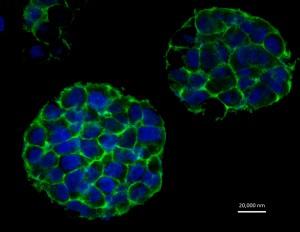There has been a tremendous amount of research being done on the 3D printing of living human cells to form bones, organs, and various other tissue. Such technology is certain to change the way the medical community  views regenerative medicine. There is another angle to this technology though, one in which 3D printing could end up being nearly as important to cancer research as it is to regenerative medicine.
views regenerative medicine. There is another angle to this technology though, one in which 3D printing could end up being nearly as important to cancer research as it is to regenerative medicine.
Researchers, led by Wei Sun, a professor in the department of mechanical engineering at Drexel University, in Philadelphia, as well as Singhua University, in China, have come up with a method of 3D printing cancer cells. They have done so, in such a way, that 90 percent of these cells survive and are able to be used in testing.
Currently billions of dollars a year are being spent on clinical trials, testing various drugs for any sign that they could help in the fight against cancer. There is a problem though. These tests use tiny, 2D, one layer thick structures of tumor cells, which allow researchers to test the various affects a drug can have on such a tumor. However, these 2D sheets are not ideal, since actual tumors are grown with not two, but three dimensions.
A 3D conglomerate of cancer cells should completely mimic that of an actual tumor found in a patient. This is where Wei Sun’s research has come into play. Sun was able to mix cervical cancer cells, with gelatin, and fibrous proteins, place them into a 3D printer,and layer by layer print out the sructure of a tumor. The cell structures were printed in a shape 10mm in length and width, and 2mm in height. After printing, he left the structures alone to grow for 8 days. As time passed they slowly formed into spherical balls of cells.
“With further understanding of these 3D models, we can use them to study the development, invasion, metastasis and treatment of cancer using specific cancer cells from patients. We can also use these models to test the efficacy and safety of new cancer treatment therapies and new cancer drugs,” said Sun.
The research being done here could potentially lead to more reliable testing of drugs, quicker FDA approval, and further understanding of how cancer cells replicate, as well as survive. The ability for researchers to have at their disposal a tomorrow of any shape or size, could one day lead to some pretty amazing discoveries, or even cures for the terrible disease. Discuss the latest on 3D printing of cancer cells, at 3dPrintboard.
(Header Image Source: : Zhao et al. Biofabrication)
(Results of study can be found at: iopscience.iop.org)
Subscribe to Our Email Newsletter
Stay up-to-date on all the latest news from the 3D printing industry and receive information and offers from third party vendors.
Print Services
Upload your 3D Models and get them printed quickly and efficiently.
You May Also Like
3D Printing News Briefs, June 11, 2025: Sustainability, Automotive Tooling, & More
We’re starting with sustainability news in today’s 3D Printing News Briefs, as EOS has strengthened its commitment on climate responsibility, and Zestep is making 3D printing filament out of eyewear...
3D Printing 50 Polymer Stand-In Parts for Tokamaks at the PPPL & Elytt Energy
Of all the world’s things, a tokamak is one of the hardest, most complex, expensive and exacting ones to make. These fusion energy devices make plasma, and use magnets to...
3D Printing News Briefs, May 17, 2025: Color-Changing Materials, Humanoid Robot, & More
We’re covering research innovations in today’s 3D Printing News Briefs! First, Penn Engineering developed 3D printed materials that change color under stress, and UC Berkeley researchers created an open source,...
Firehawk Aerospace Partners with JuggerBot 3D, Gets $1.25M from AFWERX for 3D Printed Propellants
Texas-based Firehawk Aerospace, an advanced energetic materials firm that works with aerospace and defense applications, announced a strategic partnership with JuggerBot 3D, an Ohio-based large-format 3D printer manufacturer. Together, the...


































